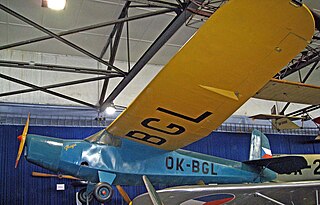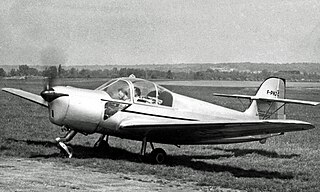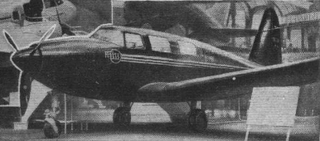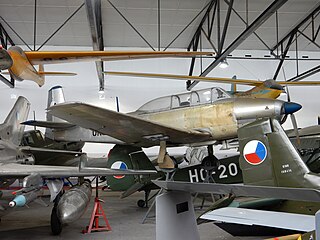
The Miles M.57 Aerovan was a British twin-engined short-range low-cost transport aircraft designed and produced by Miles Aircraft. It was primarily used for freight and passenger services.
The Boisavia B.260 Anjou was a four-seat twin-engine light aircraft developed in France in the 1950s. It was a low-wing cantilever monoplane of conventional configuration with retractable tricycle undercarriage. Intended by Boisavia as a touring aircraft, it did not find a market and only the single prototype was constructed. At this point, the firm sold the design to SIPA, which modified the design and re-engined it with Lycoming O-360 engines, but found that they could not sell it either. At a time when the twin-engine light plane market was already dominated by all-metal American aircraft, the Anjou's fabric-over-tube construction was something of an anachronism, and all development was soon ceased. Plans to develop a stretched version with three extra seats and Potez 4D engines were also abandoned.

The Morane-Borel monoplane was an early French single-engine, single-seat aircraft. It was flown in several European air races.

The Praga E.114 was a single-engine sport airplane, designed and manufactured by the Czechoslovakian company ČKD-Praga. Due to its light weight it was also called Air Baby.

The Hurel-Dubois HD.31, HD.32, and HD.34 were a family of civil aircraft produced in France in the 1950s, based on Maurice Hurel's high aspect ratio wing designs.

PZL M-2 was a Polish trainer aircraft prototype of 1958, a low-wing monoplane with fixed gear. Designed at WSK-Mielec, it did not enter production.

The SECAN SUC-10 Courlis was a French high-wing touring monoplane designed and built by Société d'Etudes et de Construction Aéronavales (SECAN), a branch of the automobile company Société des Usines Chaussons. The aircraft had problems with the engine installation and only 144 were built, some without engines and were scrapped.

The Ambrosini Rondone is an Italian-designed two/three-seat light touring monoplane of the early 1950s.

The Praga E-210 was a four-seat, twin-engined touring aircraft built in Czechoslovakia in the late 1930s. It had an unusual pusher configuration. Its tail unit and undercarriage were modified significantly before World War II and after the war a more powerful version designated E-211 was flown.
The Nord 2100 Norazur was a 1940s French military transport monoplane designed and built at Courbevoie near Paris by SNCAN.

The Morane-Saulnier MS.603 was a French-built two-seat light aircraft of the late 1940s.
The I.S.T. L-17 Masang was a two-seat, single engine, low wing monoplane aircraft designed and built in the Philippine Republic in the mid-1950s. It was intended for both touring and training.
The Morane-Saulnier MS-700 Pétrel was a French four-seat cabin-monoplane designed and built by Morane-Saulnier, only three prototypes were built.

The SNCASO SO.7010 Pégase was a six-passenger light transport aircraft developed in France immediately after World War II. It was powered by a pair of tandem-coupled V-8 engines but this power plant proved to be too troublesome for development to proceed.

The Potez 31 was a prototype French two-seat night fighter, flown in about 1928, intended to fill the Cn.2 specification for the Armee de l'Air. Only one was built.
In aeronautics, bracing comprises additional structural members which stiffen the functional airframe to give it rigidity and strength under load. Bracing may be applied both internally and externally, and may take the form of struts, which act in compression or tension as the need arises, and/or wires, which act only in tension.
The MIP Smyk, MIP from the initials of its Polish designers with Smyk meaning Brat or Kid, was an aerodynamically refined motor glider designed and built at Warsaw Technical University from 1935.

The Couzinet 30 was a light transport aircraft / mailplane designed and built in France in 1930 at Société des Avions René Couzinet.
The Hurel-Dubois Miles HDM.105 was a transport aircraft fitted with very high aspect ratio wings for research purposes, building on research carried out with the Hurel-Dubois HD.10, and a stepping point to the planned production HDM.106 Caravan. The HDM.105/HDM.106 provided the starting point for the design of the Short SC.7 Skyvan.

The TOM-8 was a prototype Czechoslovak single-engined two-seat training aircraft of the 1950s. It was designed by the VZLU, the Czechoslovak national aeronautic research institute for the Czechoslovak Air Force, with a prototype flying in 1956, but production plans were abandoned in 1960.













